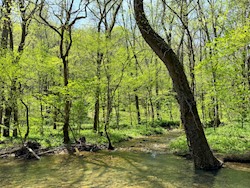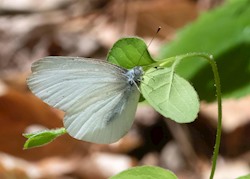West Virginia White Pieris virginiensis
Butterfly: Wingspan: 1¼ - 1¾ inches (3.5 - 4.1 cm) UPPER SURFACE (dorsal) Translucent white; gray scaling along wing edges and wing base. Females slightly grayer. Top of body is dark. UNDER SURFACE (ventral) White. Hindwings faintly suffused with gray along the veins.
ID Tip: Almost completely white with no spots or checkering.
Egg: White; spindle shaped.
Caterpillar: Downy and green, including head. Marked only with a faint lateral line and tiny blue dots.
Chrysalis: Green or tan; sharply angled. The overwintering stage.







































